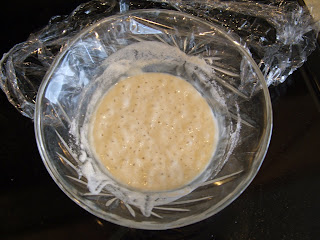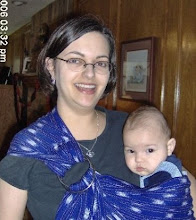I have some exciting news. My son, Chris, who is 10, will be writing short reviews of some of his summer reading on one of my other blogs, The Book Blawg. Right now he is reading through the Redwall series by Brian Jacques and the Dragon Keepers Chronicles by Donita K. Paul, although I am letting him choose his writing topics. I also plan to format the posts only but not edit his writing, as much as it irks me to publish something with grammatical errors :).
June 17, 2011
New Guest Blogger on The Book Blawg
Posted by The Mommy Blawger at 12:25 PM 0 comments
Labels: books
June 6, 2011
Sourdough Bread Part I: Starter
"You start it," said Ma, "by putting some flour and warm water in a jar and letting it stand till it sours." "Then when you use it, always leave a little," said Laura. "And put in the scraps of biscuit dough, like this, and more warm water," Laura put in the warm water, "and cover it," she put the clean cloth and the plate on the jar, "and just set in in a warm place," she set it in its place on the shelf by the stove. "And it's always ready to use, whenever you want it."
- Laura Ingalls Wilder, By the Shores of Silver Lake
Why Sourdough Bread?
For a while, I've been thinking about making my own sourdough. At a certain point, I realized that commercial baker's yeast is a processed food. You can make the most healthy, whole grain, organic bread, but if you are using yeast that you buy in the grocery store, you are adding a shelf-stable manufactured product. It's the bread equivalent of pasteurized milk - or worse, milk powder.
Second, I've been using the no-knead Artisan Bread in Five Minutes a Day
Third, we've been making some dietary changes in our family in order to address some health and behavioral problems. Primarily, this has involved removing dairy from our diets, but sometimes we wonder if the combination of dairy and gluten causes problems as well. We're not really at the point of going gluten-free, and I think we would know if anyone in our family had a serious gluten intolerance. But the bacteria and yeast in sourdough helps pre-digest the gluten in bread, in the same way that aged cheese and yogurt have less lactose than milk, because the bacteria feed on the lactose and gluten and break them down.
How to get Sourdough Starter
Sourdough starter is a symbiotic combination of wild yeast and lactobacillus. There are several different ways to get your own sourdough starter (sometimes called a sponge). You can grow your own, like Mrs. Ingalls did. You can borrow some from a friend. Most interestingly, you can order starter on the internet. San Francisco sourdough gets it's distinctive taste from the wild yeast that populate that geographical area; and you can buy Alaskan sourdough, Italian sourdough, Parisian sourdough, etc. - some strains are over 100 years old. A strain that has been around a while is bound to be dependable. Of course, some say that eventually your sourdough starter will be overtaken by your local wild yeast. Fresh sourdough starter generally runs $6- $12. King Arthur Flour is a reliable source.
However, being a frugal person, I opted for the free starter (and seeing as how this is my first time experimenting with sourdough; I don't want to pay for something only to kill it or loose interest if it doesn't work). You can get Carl Griffith's 1847 Oregon Trail Sourdough Starter free for the cost of a self-addressed stamped envelope. Instructions are at carlsfriends.net.
Carl is long gone, but his friends keep his sourdough culture alive and will dry it and send it to you. What a deal! The only drawback is that you have to take a little time to re-activate it. The Carl's Friends website has instructions. Put some in a dish, add some water, and stir:
Add a little water and flour, and when it bubbles, stir it and add a little more flour and water. The whole process takes several hours. Store it in a non-airtight container. A French canning jar with the gasket removed is perfect - it lets gasses in (and out) yet protects from accidental spillage, insects, and one-year-olds:
If you are going to be using the starter daily, keep it out at room temperature. If you need to store it, put it in the refrigerator.
Feeding Your Starter
I've only been doing this for a few weeks, so I am certainly no expert. You can find a ton of advice (often conflicting) on the internet about how to care for sourdough starter. There are YouTube videos, online courses, and endless websites. But here's the simple, what-works-for-me version:
So, the bacteria and the yeast feed on the four. After a while, they run out of flour and then the bacteria starts eating the yeast. This products hooch - the alcoholic liquid that forms on top - and is a good sign that you need to feed your yeast. Just add a tablespoon of flour and a tablespoon of water. Some sourdough experts say that you should add the same weights, not the same amounts of flour and water, so depending on the density of your flour the amount of water will be different. However, I try to keep my starter the consistency of pancake batter. So if it is too thin, I don't add so much water, and if it is thick, I add a little more. If you add too much flour and water, see what happens:
I found a great article at GNOWFLGLINS, 6 Tips to Prevent “Sour” Sourdough, which advises you to pour off the hooch rather than stir it in; and to feed the starter more often. So I feed my starter 2-3 times a day when it is out on the counter, and 3 times a week when it is in the fridge. I put in a tablespoon of flour and water, give it a stir, and that's it. If I'm going to bake bread, I take it out of the fridge several hours to a day before, feed it 1/2 a cup or so of flour and water, and let it sit until I am ready to bake.
Next up: Sourdough Bread Part II: Baking
Posted by The Mommy Blawger at 2:16 PM 0 comments
Labels: recipes bread
Subscribe to:
Posts (Atom)





